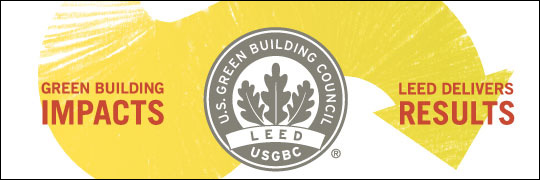
WHAT LEED IS
LEED is an internationally recognized green building certification system, providing third-party verification that a building or community was designed and built using strategies aimed at improving performance across all the metrics that matter most: energy savings, water efficiency, CO2 emissions reduction, improved indoor environmental quality, and stewardship of resources and sensitivity to their impacts.
Developed by the U.S. Green Building Council (USGBC), LEED provides building owners and operators a concise framework for identifying and implementing practical and measurable green building design, construction, operations and maintenance solutions.
LEED is flexible enough to apply to all building types – commercial as well as residential. It works throughout the building lifecycle – design and construction, operations and maintenance, tenant fitout, and significant retrofit. And LEED for Neighborhood Development extends the benefits of LEED beyond the building footprint into the neighborhood it serves.
WHAT LEED DELIVERS
Third-party certification through the independent Green Building Certification Institute (GBCI.org) assures that LEED buildings are constructed as intended. GBCI includes a network of ISO-compliant international certifying bodies, ensuring the consistency, capacity and integrity of the LEED certification process.
An organization’s participation in the voluntary and technically rigorous LEED process demonstrates leadership, innovation and environmental stewardship.
WHAT LEED MEASURES
LEED is a voluntary certification program that can be applied to any building type and any building lifecycle phase. It promotes a whole-building approach to sustainability by recognizing performance in key areas:
 |
Sustainable Sites Choosing a building's site and managing that site during construction are important considerations for a project’s sustainability. The Sustainable Sites category discourages development on previously undeveloped land; minimizes a building's impact on ecosystems and waterways; encourages regionally appropriate landscaping; rewards smart transportation choices; controls stormwater runoff; and reduces erosion, light pollution, heat island effect and construction-related pollution.
|
 |
Water Efficiency Buildings are major users of our potable water supply. The goal of the Water Efficiency credit category is to encourage smarter use of water, inside and out. Water reduction is typically achieved through more efficient appliances, fixtures and fittings inside and water-wise landscaping outside.
|
 |
Energy & Atmosphere According to the U.S. Department of Energy, buildings use 39% of the energy and 74% of the electricity produced each year in the United States. The Energy & Atmosphere category encourages a wide variety of energy strategies: commissioning; energy use monitoring; efficient design and construction; efficient appliances, systems and lighting; the use of renewable and clean sources of energy, generated on-site or off-site; and other innovative strategies.
|
 |
Materials & Resources During both the construction and operations phases, buildings generate a lot of waste and use a lot of materials and resources. This credit category encourages the selection of sustainably grown, harvested, produced and transported products and materials. It promotes the reduction of waste as well as reuse and recycling, and it takes into account the reduction of waste at a product’s source.
|
 |
Indoor Environmental Quality The U.S. Environmental Protection Agency estimates that Americans spend about 90% of their day indoors, where the air quality can be significantly worse than outside. The Indoor Environmental Quality credit category promotes strategies that can improve indoor air as well as providing access to natural daylight and views and improving acoustics.
|
 |
Locations & Linkages The LEED for Homes rating system recognizes that much of a home's impact on the environment comes from where it is located and how it fits into its community. The Locations & Linkages credits encourage homes being built away from environmentally sensitive places and instead being built in infill, previously developed and other preferable sites. It rewards homes that are built near already-existing infrastructure, community resources and transit, and it encourages access to open space for walking, physical activity and time spent outdoors.
|
 |
Awareness & Education The LEED for Homes rating system acknowledges that a green home is only truly green if the people who live in it use the green features to maximum effect. The Awareness & Education credits encourage home builders and real estate professionals to provide homeowners, tenants and building managers with the education and tools they need to understand what makes their home green and how to make the most of those features.
|
 |
Innovation in Design The Innovation in Design credit category provides bonus points for projects that use new and innovative technologies and strategies to improve a building’s performance well beyond what is required by other LEED credits or in green building considerations that are not specifically addressed elsewhere in LEED. This credit category also rewards projects for including a LEED Accredited Professional on the team to ensure a holistic, integrated approach to the design and construction phase.
|
 |
Regional Priority USGBC’s regional councils, chapters and affiliates have identified the environmental concerns that are locally most important for every region of the country, and six LEED credits that address those local priorities were selected for each region. A project that earns a regional priority credit will earn one bonus point in addition to any points awarded for that credit. Up to four extra points can be earned in this way. See the Regional Priority Credits for your state » |
all information provided by U.S. Green Building Council

